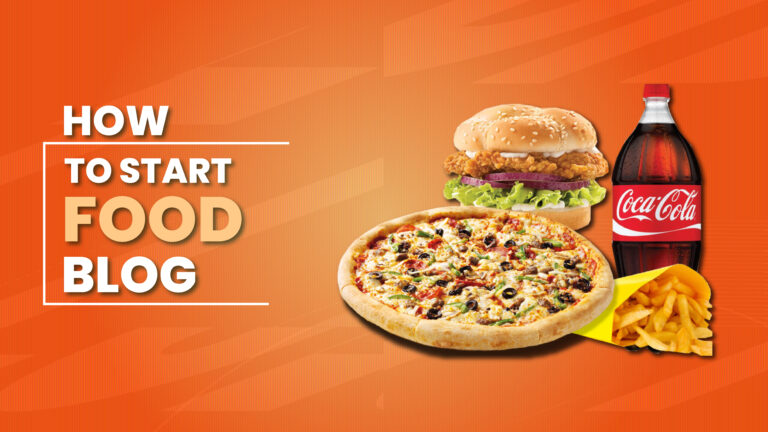Food blogging in 2026 continues to be one of the most exciting and rewarding ways to share your passion for cooking, culture, and creativity. With millions of people searching daily for fresh recipes, quick meal ideas, and the latest food trends, there’s always room for a new voice in the culinary world. Starting a food blog lets you turn your love for food into a personal brand, build a loyal audience, and even earn income doing what you enjoy. However, success doesn’t come from posting recipes alone; it takes clear niche selection, strong SEO, engaging storytelling, and smart monetization. This step-by-step guide will show you exactly how to start a food blog in 2026 that attracts readers and keeps them coming back for more.
What Is a Food Blog?
A food blog is a website or online platform where individuals share content about food, including recipes, cooking tips, restaurant reviews, nutrition advice, and food photography. It’s a creative space where food lovers express their passion, teach others how to cook, and often build a brand around their culinary style. Many food blogs also earn income through ads, affiliate links, or collaborations with food brands.
Key Points:
- Shares recipes, cooking guides, and meal ideas.
- Often includes food photography and videos.
- May feature restaurant reviews or cultural food stories.
- Connects food lovers through personal experiences and tips.
- Can be monetized via ads, sponsorships, or digital products.
The Importance of Food Photography
In the world of food blogging, photography isn’t just decoration, it’s storytelling. High-quality food photos capture attention, increase engagement, and make readers trust your recipes. In 2026, where visuals dominate online content, compelling food photography can make or break your blog’s success.
Why Food Photography Matters
- First Impressions Count: A beautifully shot dish draws readers in before they even read the recipe.
- Boosts SEO and Shares: Visually appealing content performs better on Pinterest, Instagram, and Google Images.
- Builds Credibility: Clear, professional-looking photos make your recipes appear trustworthy and worth trying.
- Drives Conversions: Better images lead to more clicks, shares, and affiliate sales.
Simple Photography Tips for Food Bloggers
- Use Natural Lighting: Shoot near a window for soft, flattering light.
- Keep Backgrounds Neutral: Use wood, marble, or plain backdrops to make food the focus.
- Shoot from Multiple Angles: Overhead for flat lays, 45° for depth, and close-ups for detail.
- Edit Thoughtfully: Use tools like Lightroom or Canva to adjust brightness, contrast, and sharpness.
- Be Consistent: Stick to a cohesive photography style that reflects your blog’s brand.
Even if you start with a smartphone, mastering composition and lighting can instantly elevate your content and help your food blog stand out.
Essential Steps to Start a Food Blog in 2026
1. Select a Niche for Your Food Blog
Choosing a well-defined niche is essential to stand out in the crowded food blogging world. Instead of covering every type of recipe, focus on a specific segment that reflects your passion and expertise. This approach helps attract a loyal, targeted audience and improves your chances of ranking higher in search results.
Popular Food Blog Niches in 2026
- Vegan and Plant-Based Recipes: Sustainability trends continue to drive interest in plant-based cooking.
- Keto and Low-Carb Meals: A consistent favorite among health-conscious readers.
- Gluten-Free Cooking: Serves a dedicated community with specific dietary needs.
- International Cuisine: Focuses on cultural dishes and authentic recipes from around the world.
- Quick and Easy Meals: Appeals to busy professionals seeking simple, healthy recipes.
- Meal Prep and Planning: Offers practical solutions for efficient, organized cooking.
How to Choose the Right Niche
- Identify what type of food or cooking style you love most.
- Research trending topics and existing competitors.
- Choose a focus area that is narrow enough to build authority yet broad enough to keep your content varied.
2. Select the Right Blogging Platform
Your blogging platform determines how your website functions and performs. In 2026, several platforms will cater specifically to content creators with powerful SEO tools and design flexibility.
Top Blogging Platforms for Food Bloggers
- WordPress.org: The most flexible and SEO-friendly option, ideal for long-term growth.
- Squarespace: User-friendly with modern templates and drag-and-drop design tools.
- Wix: Easy to use, beginner-friendly, and quick to set up.
- Ghost: Lightweight, fast, and perfect for minimalist blogs.
Why WordPress is the Best Choice
WordPress remains the top choice for food bloggers due to its customization options and wide range of plugins. Use themes like Foodie Pro or Cookely for beautiful layouts, and install WP Recipe Maker for easy recipe formatting and Yoast SEO for optimization.
3. Pick a Domain Name and Hosting
Your domain name and hosting service are the foundation of your blog’s success. A strong domain makes your brand memorable, while reliable hosting ensures your website loads quickly and remains secure.
Tips for Choosing a Domain Name
- Keep it short and easy to spell (e.g., QuickKetoBites.com).
- Include relevant keywords such as “vegan,” “keto,” or “recipes.”
- Make it unique and brandable to stand out in search results.
Recommended Hosting Providers in 2026
- Bluehost: Affordable and beginner-friendly, optimized for WordPress.
- SiteGround: Excellent speed and customer support.
- Kinsta: Premium hosting with top-tier performance and security.
- WP Engine: A reliable option for high-traffic WordPress blogs.
After setting up your domain and hosting, install WordPress and add essential plugins like Yoast SEO for optimization and Tasty Pins to improve Pinterest sharing.
4. Design a Beautiful, User-Friendly Food Blog
A well-designed blog enhances user experience and builds trust with your readers. Focus on clarity, usability, and high-quality visuals that reflect your brand’s style.
Key Design Elements
- Mobile-Responsive Theme: Ensure your blog is easy to navigate on all devices. Themes like Astra and Divi perform well across platforms.
- Recipe Index: Create a categorized section to help visitors find recipes easily.
- High-Quality Images: Invest in professional photography or learn basic food styling. Optimize images for fast loading.
- Clear Call-to-Action: Add newsletter sign-ups, social media buttons, and recipe download options.
Enhancing User Experience
- Use sticky navigation for smooth browsing.
- Include printable recipe cards using WP Recipe Maker.
- Add recipe summaries and ratings to boost engagement.
5. Create Engaging and Valuable Content
Quality content is the foundation of your blog’s success. Focus on authenticity, consistency, and helpfulness to keep readers coming back.
Content Ideas for Food Bloggers
- Recipes: Detailed, step-by-step instructions with visuals.
- Cooking Tips: Share insights on ingredient preparation, storage, or time-saving hacks.
- Product Reviews: Review kitchen gadgets or ingredients relevant to your niche.
- Nutrition Tips: Provide educational content related to diets and healthy eating.
- Seasonal Recipes: Publish festive or seasonal dishes to attract timely traffic.
Recipe Writing Best Practices
- Use clear measurements and timeframes.
- Avoid vague language like “a bit” or “a few minutes.”
- Include prep time, cook time, and serving size.
- Add an FAQ section at the end of each recipe to address common questions.
6. Focus on SEO Optimization
Strong SEO ensures your food blog is visible to readers searching online. Implementing best practices early on helps your content rank higher on Google and other search engines.
On-Page SEO Techniques
- Conduct keyword research using Ahrefs or SEMrush.
- Optimize meta titles, descriptions, and image alt text.
- Link internally to related blog posts.
- Use descriptive, keyword-rich URLs.
Off-Page SEO Strategies
- Build backlinks through guest posts and collaborations.
- Share and promote your content across Pinterest, Instagram, and Facebook.
- Encourage engagement and respond to reader comments to strengthen community trust.
7. Build a Strong Social Media Presence
Social media is a vital tool for growing your blog’s reach. Choose the platforms where your target audience is most active and maintain a consistent posting schedule.
Best Platforms for Food Bloggers
- Pinterest: A top traffic driver for recipe-based content.
- Instagram: Perfect for sharing photos, reels, and behind-the-scenes stories.
- YouTube: Ideal for detailed cooking tutorials and long-form videos.
- TikTok: Short, engaging recipe clips can quickly go viral.
Plan your posts using a content calendar and repurpose blog articles into social-friendly formats.
8. Monetize Your Food Blog
Once you establish consistent traffic and engagement, explore ways to earn income from your blog.
Popular Monetization Methods
- Affiliate Marketing: Promote kitchen tools or ingredients and earn commissions on sales.
- Sponsored Posts: Collaborate with food brands to create paid content.
- Display Ads: Use ad networks like Mediavine or Google AdSense.
- Digital Products: Sell eBooks, meal plans, or online cooking courses.
- Memberships or Subscriptions: Offer exclusive recipes or bonus content for paying members.
Conclusion
Starting a food blog in 2026 requires a blend of creativity, strategy, and consistency. With the right planning and focus, you can turn your passion for cooking into a thriving online brand. By choosing a clear niche, implementing strong SEO practices, and using social media effectively, you can attract a loyal audience that keeps coming back for more. Whether your specialty is plant-based recipes, quick weeknight dinners, or gluten-free desserts, a well-structured food blog can lead to exciting opportunities for growth, collaboration, and income.
To create a successful food blog in 2026, focus on producing SEO-optimized content, sharing engaging visuals, and using social media platforms like Pinterest, Instagram, and YouTube to expand your reach. Consistency in posting, keyword research, and recipe formatting will not only improve your search rankings but also enhance user experience.
Also Read This:
How to Start an Italian Food Blog in 2026
How to Start a Food Citric Blog in 2025
How to Start a Recipe Blog in 2026
Frequently Asked Questions (FAQs)
What is the best blogging platform for food bloggers in 2025?
WordPress is the best platform due to its flexibility, customization options, and SEO tools.
How can I monetize my food blog?
You can monetize through affiliate marketing, sponsored posts, display ads, selling ebooks, and offering subscriptions.
Do I need professional photography for my food blog?
While professional photography improves the appeal of your blog, high-quality smartphone photos can also work with good lighting and presentation.
How important is SEO for food blogs?
SEO is crucial for driving organic traffic. Optimize your content, use keywords, and focus on both on-page and off-page SEO strategies.
How often should I post new recipes on my food blog?
Consistency is key. Aim for at least 1-2 posts per week to keep your audience engaged and improve your SEO rankings.

